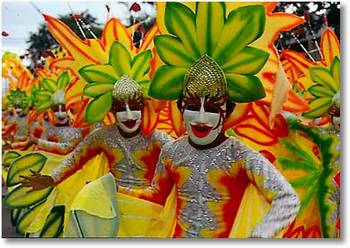While pottery, weaving and wooden carvings are a part of traditional art forms in the Philippines, one will also find many works of art that bear influence from when the country was colonised by the Spanish. Such works can be seen through the elaborate frescoes, sculptures and paintings within the country’s churches, depicting imagery and characters from the Bible.
A form of traditional culture that can be seen to this day is the country’s various folk dances such as ‘carinosa’, ‘singkil’ and ‘tinikling’. The fascinating style of ‘tinikling’ includes the use of long bamboo sticks kept in a horizontal position near the ground and which are moved rapidly with the beat of accompanying music. The dancers in turn have to skilfully avoid these bamboo sticks while keeping to their routine.
The music of the Philippines has also been shaped by a variety of influences, both indigenous and foreign. While traditional Filipino music involves indigenous sounds, the subsequent colonisation of the Spanish led to local music incorporating such instruments as drums, guitars, violins and trumpets which were commonly used by the colonizing communities during the celebration of festivals. With increasing American influence, the country has today its own unique blend of Filipino hip hop and rock as well.
Local cuisine also plays a big part in Filipino culture with each province in the country boasting its own preparation methods. Like in most Asian countries, rice is a staple diet here and can be served with a variety of other dishes such as a chicken or pork stew called ‘adobo’, roasted pig and ‘lumpia’ which are rolls made from either vegetables or meat.
Serviced apartments Manila offer a contemporary home away from home that have self catering facilities. Ideal for both business and leisure travellers looking for a long stay apartment Manila, Somerset Salcedo Makati enjoys a central location and gives one a chance to explore the city and experience some Filipino culture.









